with photos from various sources. The recommended mode of Hajj for pilgrims from abroad (ie. outside of KSA) is the Hajj at-Tamattu method. [Saheeh Muslim Vol.2, p.612, no.2803]

And perform properly (i.e. all the ceremonies according to the ways of Prophet Muhammad), The Hajj and Umrah (i.e. the pilgrimage to Makkah) for Allaah.... [Al Qur'ân 2:196]
Advice
You will wear your Ihraam before you commence your air journey. Then the Neeyah (intention) for Umrah must be made as soon as you reach the Meeqat. The points of Meeqat are shown in the two maps below:
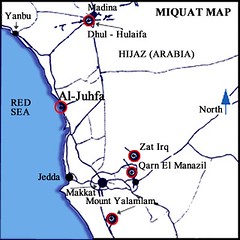
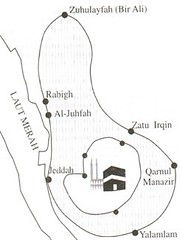
The airline Captain will tell you when you reach the Meeqaat. The Neeyah on or before reaching the Meeqat is:
LabbaikAllaahumma bi Umrah (O Allaah! Here I am responding to You in performing the Umrah.)
On arrival at Makkah you will perform the rites of Umrah, shorten your hair and come out of the state of Ihraam. [Saheeh Muslim vol.2, p.612, no.2803]
On the 8th of Dhul Hijjah (also known as Yaum at-Tarwiyah) you will wear the Ihraam (at your residence in Makkah) after you take a bath and then pronounce the Neeyah as follows:

Labbaik Allaahumma bi Hajj (O Allaah! Here I am responding to You in performing the Hajj.) [Saheeh Muslim vol.2, p.612, no.2803]
After pronouncing the neeyah, you will leave for Minaa saying the Talbeeyah aloud. The Talbeeyah is as follows:
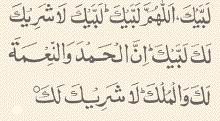
Labbaik Allaahumma labbaik, labbaik laa shareeka laka labbaik innal hamda wan-ni'mata laka wal mulk laa shareeka lak (Here am I, O Allaah, Here am I. There is no associate with You. Here am I. Surely all praise and graces are Yours, and so is the dominion! There is no associate with You.) [Saheeh al-Bukhaaree vol.2, p.361, no.621]
You will repeat this till the 10th day of Dhul Hijjah (called Yaum an-Nahr).
This is the only instant where the Neeyah is declared aloud and it was never the practice of the Prophet to declare aloud the Neeyah for anything else be it Prayer, for Sawm, Tawaaf or Sa’ee. The text of what is popularly read in the books as the Neeyah for the aforementioned things are all innovations. May Allaah guide us to the correct path! After making the intention, the pilgrim may say:

Allaahumma haadhihi hajjah, laa riyaa’a feehaa wa laa sum’ah
(O Allaah this is a Hajj, there being no ostentation in it or hypocrisy.) [From Ad-Diyaa with saheeh isnaad]
When making Talbeeyah of intention a pilgrim may also state a condition to Allaah as the Prophet " taught:
taught:

Allaahumma mahillee haithu habastanee (O Allaah the place where I take off my Ihraam, is where You restrain me.)
The one who does this and is prevented from completing Hajj or Umrah - there is no compensatory sacrifice due from him, nor does he have to repeat his Hajj, unless it is his first one. [Saheeh Muslim, vol.2, p.597, no.2756]
Some Important Points
a) When you enter the Masjid al-Haram in Makkah, do so with your right foot [Hadeeth hasan: ‘As-Saheehah’] and do not forget to say:

Bismillaah wassaalatu wassalaamu ala Rasoolillaah. Allaahummaf-tah lee abwaaba rahmatik (I begin with the name of Allaah. May Allaah render Rasoolullaah safe from every evil. O Allaah! Open for me the gates of Your Mercy.) [Saheeh ul Kaleema at-Tayyeebah]
b) On the 8th of Dhul Hijjah you will assume the ihraam in Makkah and leave for Minaa, saying the Talbeeyah aloud.

path for Hajj
At Minaa remember to shorten your prayers but not join them. Spend the night in Minaa.

The Tent City of Minaa - I

The Tent City of Minaa - II

Tents of Minaa behind the iron fence

The inside of a Minaa Tent
Arafat through Muzdalifah
c) Move to Arafah, passing through Muzdalifah, after sunrise. Repeat the Talbeeyah. There is no harm if you recite also the Takbeer. [Saheeh al-Bukhaaree vol.2, p.422, no.721]

Muzdalifah {road and washrooms. in reality there is no greenery :)}

Namira Mosque at Arafat

Tents and Namira Mosque at Arafat
d) Remember to stay within the boundaries of Arafah. If you do not do this your Hajj is invalid.

Stay at Arafah until sunset

Arafah boundaries, Namirah Mosque is split by the boundary
e) Leave Arafah after sunset.
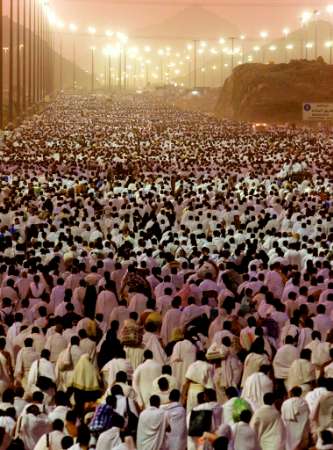
going to Muzdalifah from Arafah after sunset
f) Pray Maghrib and Ishaa prayers combined at Muzdalifah.
g) Pick up 7 pebbles at Muzdalifah, then the rest at Minaa.
STONING OF JAMAARAT
h) Throw your 7 pebbles at Jamrat al-Aqabah (the large Jamrat and the furthest away from the direction of Muzdalifah)
The picture shows the old way of stoning the Jamarat, PILLARS. This has now been vastly improved by wide bridges, and walls instead of pillars. The pilgrim should walk up the bridge, and not try to throw stones at the beginning of the wall, but continue walking until he finds a suitable spot to throw stones from. The return should not be an about turn, but continue walking and find your way out aay from the wall. It really is easy if you are sensible, and not fightened and don't do it in a hurry.

stoning at an old Jamarah pillar
Tawaaf
To perform Tawaaf you must have wudoo and should also be clean and free from all kinds of dirt. During the Tawaaf you should remember Allaah and verily all praise is for Allaah, we praise Him and pray to Him alone. You can also recite the Noble Qur’aan. There is no supplication (du'aas) recorded in the authentic traditions other than the recitals that we have mentioned.
The starting point of the Tawaaf is the Black stone as per the diagram shown in this guide. It is fixed to the south-eastern corner of the Ka’bah. The pilgrim first touches it with the right hand saying:

Bismillaah Allaahu Akbar (I begin with the name of Allaah, Allaah is the Greatest) and kisses it. Do not hurt other pilgrims while attempting to kiss the Black Stone. If you are unable to kiss it due to the crowd, then you should touch it and kiss your hand. If you cannot do this as well, then you should only point your right hand to the Black Stone saying:

Allaahu Akbar (Allaah is the Greatest.) When doing this do not kiss your hand. [Saheeh al-Bukhaaree vol.2, p.397, no.682] Between the Yemeni corner and the Black stone recite:

Rabbana Aatina Fid-dunyaa Hasanatan wa fil-aakhirati Hasanatan wa Qinaa Adhaaban-Naar (Our Lord! Give us in this world that which is good and in the Hereafter that which is good, and save us from the torment of the Fire!) [Sunan Abu Dawood vol.2, p.498, no.1887] The male pilgrim covers the first three rounds of Tawaaf at a brisk pace, up to the Yemeni Corner. This is called ‘Raml’. The stretch from the Yemeni Corner to the Black Stone must be done at normal pace. The rest of the rounds and the seven rounds of female pilgrims are also done at the usual pace. [Saheeh al-Bukhaaree vol.2, p.393, no.672]
The male pilgrim should wear the Ihraam during the Tawaaf al Qudum (the Tawaaf of arrival) with the middle of the rida’ (the top portion of the Ihraam) under the shoulder leaving the right shoulder bare. The ends of the rida’ meet on the left shoulder. This is called ‘Idtiba’ [Sunan Abu Dawood vol.2, p.495, no.1879]
The Performance of Tawaaf


(Hajr ul-Aswad) The Black Stone

The practice of Idtiba and Raml is only for Tawaaf al-Qudum. Do not do Idtiba or Raml for Tawaaf al-Ifaada or Tawaaf al-Wadaa. Always cover your shoulders at prayer. [Saheeh al-Bukhaaree vol.1, p.218, no.355]
After completion of the Tawaaf, pray two rak’aahs at Maqaame Ibraheem. If it is not possible, for any reason to pray here, due to crowd or otherwise, then pray anywhere in the Mosque. It is sunnah to recite Soorah Al-Kaafiroon in the first rak’aah and Soorah Al-Ikhlaas in the second. [Saheeh Muslim vol.2, p.612, no.2803] After this proceed to the Zamzam well and drink of its water and pour some on the head. Go back to the Black Stone, say Takbeer and touch it with your right hand, if it is possible.
Sa’ee
When you reach the foot of Safaa recite

recitation when going for Sa`ee
Innas-Safaa wal Marwata min Sha’aa’irillaah faman hajjal-Baita awi’ tamara fla junaha alaihi ayyattawwafa bihinna waman tatawwa’a khairan fa’innallaaha shaakirun ‘aleem (Verily, as-Safa, and al-Marwah are among the rites of Allaah, so there is no sin upon him who performs Hajj or the Umrah to walk back and forth between them. And whoever does good voluntarily, then verily Allaah is appreciative and All-Knowing.) Then climb As-Safaa till you see the Ka’bah, facing it make Tawheed of Allaah saying:

say Tawheed on facing Ka`aba at Safa
Laa ilaaha illallaah (There is no true god except Allaah alone.)
Then make Takbeer saying:

say Takbeer on facing Ka`aba at Safa
Allaahu Akbar (Allaah is the Greatest) 3 times, then say:

say Hajj_dua on facing Ka`aba at Safa
Laa ilaaha illallaahu Wahdahu laa shareekalahu lahul mulku wa lahul hamdu wa huwa ‘alaa kulli shai’in qadeer. Laa illaaha illallaahu wahdahu laa shareekalahu anjaza wa’dahu wanasara ‘abdahu wa hazamal ahzaaba wahdah (There is no true god except Allaah alone, Who is without partner. His is the kingdom, all praise is due to Him and He is able to do all things. There is no true god except Allaah alone, Who is without partner. He fulfilled His promise, and made His slave prevail, and He defeated the clans all alone) 3 times. You may make du'aa after each time. Then you descend for sa’ee between Safaa and Marwah and walk till you reach the green sign post on the right and left - then run till the next sign post. Thereafter proceed walking to Marwah and ascend it and repeat what you did in as-Safaa facing the Qiblah saying Takbeer and Tahleel and making du'aa to complete one circuit. Then return to as-Safaa, running at the place for running and completing the second circuit and so on until you complete seven circuits. After finishing the seventh circuit ending at Marwah, shorten the hair of your head to complete your Umrah. [Saheeh Muslim vol.2, p.612, no.2803]

Sa`ee ground
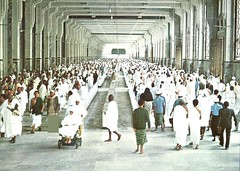
Sa`ee

Hajj haram
Important notes:
1. If your Tawaaf is interrupted due to congregational prayers, resume from the Black Stone disregarding the incomplete round.
2. Shorten your hair after Umrah but shave your head on the 10th of Dhul-Hijjah. This is more meritorious than shortening as the Prophet said: “O Allaah have mercy on those who shave their heads”, the people said ‘And those who shorten their hair O Rasoolullaah? He said: “O Allaah have mercy on those who shave their heads”, the people said ‘And those who shorten their hair O Rasoolullaah? He added on the fourth time: “And those who shorten their hair.” [Saheeh al-Bukhaaree vol.2, p.455, no.785]
3. On the 10th of Dhul Hijjah, once the stoning is complete, all restrictions except sexual intercourse are lifted and you may change out of your ihraam garments and wear perfume. But you must complete your Tawaaf al-Ifaada before maghrib on the same day. If you are unable to do so, then you must resume your ihraam and perform the tawaaf al-Ifaada after which you may come out of ihraam. [Sunan Abu Dawood vol.2, p.530, no.1994]
4. The best dhikr is

best dhikr
Laa ilaaha illallaahu wahdahu laa shareekalahu lahul mulku wa lahul hamdu wa huwa ‘alaa kulli shai’in qadeer. (There is no true god except Allaah alone, Who is without partner. His is the kingdom, all praise is due to Him and He is able to do all things.) So repeat this as much as you can.














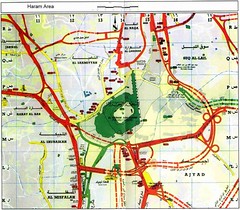


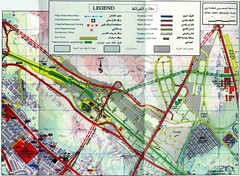
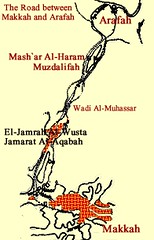
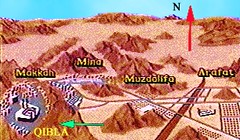
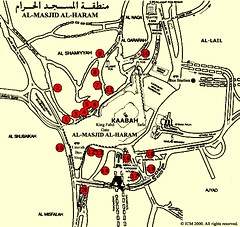
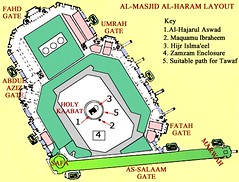








 taught:
taught:

























